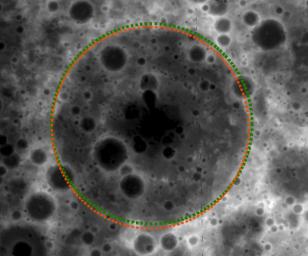
|
Hunting for Ancient Lunar Impact Basins
- Click the image above for a larger view
- Full-Res JPEG (1024 x 853) (83.2 kB)
- Full-Res TIFF (1024 x 853) (876.1 kB)
Caption:
A lesser-known impact basin, Freundlich-Sharonov, is visible in this Digital Terrain Model (DTM) made from LROC WAC stereo images, and darker shades represent lower elevations than brighter shades. The diameter of the orange-colored ring is 595 kilometers or 370 miles. DTM images like these allow scientists to inventory and study the morphologies of lunar basins.
Large impact structures represent important time markers and clues to the early history of the Moon. Unfortunately, older basins may be highly degraded and are sometimes difficult to identify in images. DTMs allow more confident identifications of lunar basins and study of their morphologies. Large numbers of tentatively identified lunar impact basins, thoroughly listed in catalogs, are awaiting verification and detailed investigation of their ages.
Background Info:
NASA's Goddard Space Flight Center built and manages the mission for the Exploration Systems Mission Directorate at NASA Headquarters in Washington. The Lunar Reconnaissance Orbiter Camera was designed to acquire data for landing site certification and to conduct polar illumination studies and global mapping. Operated by Arizona State University, LROC consists of a pair of narrow-angle cameras (NAC) and a single wide-angle camera (WAC). The mission is expected to return over 70 terabytes of image data.
Cataloging Keywords:
| Name | Value | Additional Values |
|---|---|---|
| Target | Moon | |
| System | Earth | |
| Target Type | Satellite | |
| Mission | Lunar Reconnaissance Orbiter (LRO) | |
| Instrument Host | Lunar Reconnaissance Orbiter | |
| Host Type | Orbiter | |
| Instrument | Lunar Reconnaissance Orbiter Camera (WAC) | |
| Detector | Narrow Angle Camera (NAC), Wide Angle Camera (WAC) | |
| Extra Keywords | Color, Impact | |
| Acquisition Date | ||
| Release Date | 2010-06-09 | |
| Date in Caption | ||
| Image Credit | NASA/GSFC/Arizona State University | |
| Source | photojournal.jpl.nasa.gov/catalog/PIA13194 | |
| Identifier | PIA13194 | |
